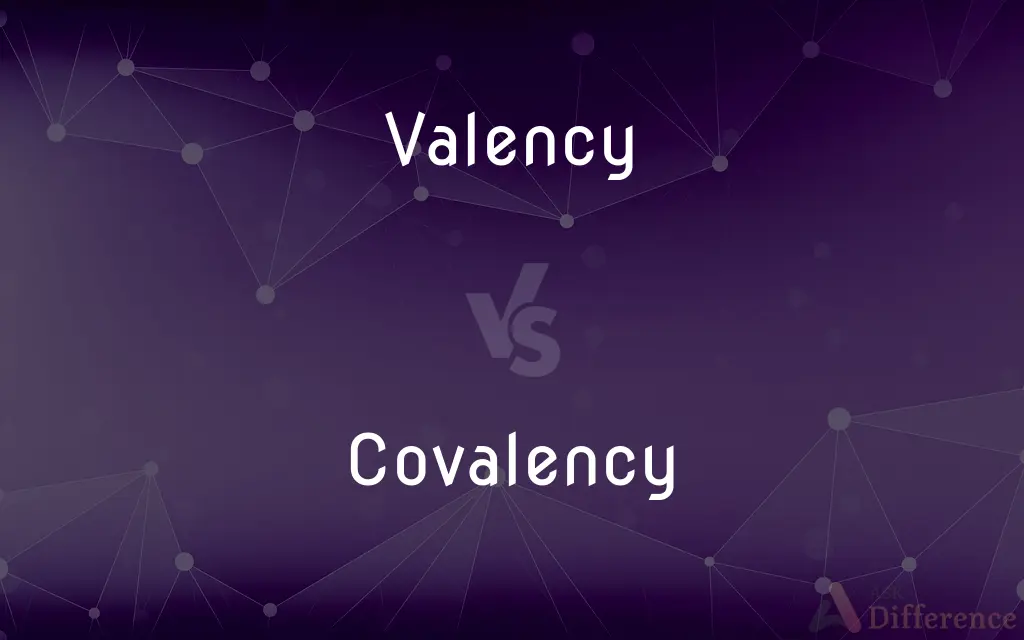Valency vs. Covalency — What's the Difference?
By Tayyaba Rehman — Updated on September 23, 2023
Valency refers to the number of bonds an atom can form with other atoms. Covalency specifically refers to the number of electron pairs an atom can share with another atom in a covalent bond.

Difference Between Valency and Covalency
Table of Contents
ADVERTISEMENT
Key Differences
Valency is a term used in chemistry to describe the ability of an atom to form bonds with other atoms. Covalency, on the other hand, is used to express the number of electron pairs an atom can share when it forms a covalent bond. Valency can apply to multiple types of bonds, including covalent, ionic, and metallic bonds, whereas covalency is solely concerned with covalent bonds.
Valency is often determined by the number of electrons in the outermost shell of an atom that can be involved in bonding. Covalency refers specifically to the number of electron pairs shared between atoms in a covalent bond. So, while valency can tell you how many bonds an atom might form, covalency will tell you specifically how many pairs of electrons are being shared in a covalent bond.
In terms of practical applications, valency is widely used to understand the stoichiometry of compounds, or how atoms combine in specific ratios. Covalency is particularly important in organic chemistry, where understanding the nature of covalent bonds is critical for interpreting the behavior of organic compounds.
Valency can vary depending on the context and the particular atom in question. For example, sulfur has a valency of 2 in hydrogen sulfide (H2S) but a valency of 6 in sulfur hexafluoride (SF6). Covalency, on the other hand, is generally fixed for a given bond; for example, the covalency between two oxygen atoms in an O2 molecule is always 2.
Comparison Chart
Applicability
General, multiple bond types
Specific, covalent bonds
ADVERTISEMENT
Determines
Number of bonds an atom can form
Number of electron pairs shared
Context Dependency
Can vary depending on atom and bond
Generally fixed for a given bond
Practical Applications
Used in stoichiometry
Important in organic chemistry
Concept Origin
General chemistry
Covalent bond theory
Compare with Definitions
Valency
Determined by the number of outer-shell electrons available for bonding.
The valency of oxygen is 2.
Covalency
Specific to covalent bonds.
Covalency helps us understand how atoms share electrons in organic compounds.
Valency
Used in stoichiometry to understand how atoms combine.
Understanding valency is critical for balancing chemical equations.
Covalency
The number of electron pairs an atom shares in a covalent bond.
The covalency between two hydrogen atoms in an H2 molecule is 1.
Valency
May vary depending on the context.
In different compounds, the valency of an element like sulfur can vary.
Covalency
Important in understanding organic chemistry.
Covalency is crucial for analyzing the structures of organic molecules.
Valency
The ability of an atom to form bonds with other atoms.
The valency of hydrogen is 1.
Covalency
Generally fixed for a specific bond.
The covalency of an oxygen-oxygen double bond is 2.
Valency
The combining power of an element, especially as measured by the number of hydrogen atoms it can displace or combine with
Carbon always has a valency of 4
Covalency
Derived from covalent bond theory.
The concept of covalency emerged from studies of covalent bonding.
Valency
Variant of valence.
Covalency
The number of electron pairs an atom can share with other atoms.
Valency
Senseid|en|chemistry}}{{alternative form of valence
Covalency
(chemistry) covalence
Valency
The capacity of something to combine with other things, as for example the capability of a vaccine as measured by the number of pathogen serotypes that it can counteract.
Vaccine valency
Covalency
Valence characterized by the sharing of electrons in a chemical compound; the number of pairs of electrons an atom can share
Valency
The number of edges connected to a vertex in a graph.
Valency
Senseid|en|linguistics}}{{alternative form of valence
Valency
(uncountable) Importance, significance.
Valency
See Valence.
Valency
The phenomenon of forming chemical bonds
Valency
(biology) a relative capacity to unite or react or interact as with antigens or a biological substrate
Valency
(chemistry) a property of atoms or radicals; their combining power given in terms of the number of hydrogen atoms (or the equivalent)
Valency
Can apply to different types of chemical bonds.
The concept of valency is useful in understanding both ionic and covalent bonds.
Common Curiosities
What is covalency?
Covalency is the number of electron pairs an atom shares in a covalent bond.
How is valency determined?
Valency is determined by the number of outer-shell electrons available for bonding.
How is covalency determined?
Covalency is determined by the number of electron pairs shared in a covalent bond.
What is valency?
Valency is the ability of an atom to form bonds with other atoms.
Is valency specific to a type of bond?
No, valency can apply to multiple types of bonds including ionic, covalent, and metallic.
Can valency vary?
Yes, valency can vary depending on the atom and the type of bond.
Can elements have multiple covalencies?
Generally, the covalency is fixed for a specific type of covalent bond.
Is covalency variable?
Generally, covalency is fixed for a specific covalent bond.
What is valency used for?
Valency is used in stoichiometry and to understand how atoms combine in compounds.
Is covalency specific to a type of bond?
Yes, covalency is specific to covalent bonds.
Can elements have multiple valencies?
Yes, some elements can exhibit multiple valencies depending on the compound.
Where did the concept of valency originate?
The concept of valency originates from general chemistry.
Where did the concept of covalency originate?
The concept of covalency comes from covalent bond theory.
What is covalency used for?
Covalency is important in organic chemistry and covalent bond theory.
Is understanding both valency and covalency important for chemists?
Yes, both concepts are foundational for understanding chemical bonding and reactions.
Share Your Discovery

Previous Comparison
Wheat vs. Rye
Next Comparison
Handcrafted vs. HandicraftAuthor Spotlight
Written by
Tayyaba RehmanTayyaba Rehman is a distinguished writer, currently serving as a primary contributor to askdifference.com. As a researcher in semantics and etymology, Tayyaba's passion for the complexity of languages and their distinctions has found a perfect home on the platform. Tayyaba delves into the intricacies of language, distinguishing between commonly confused words and phrases, thereby providing clarity for readers worldwide.














































